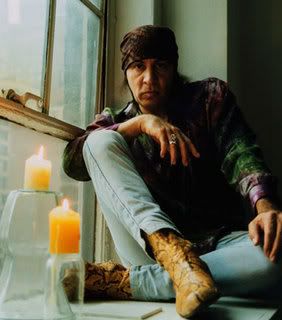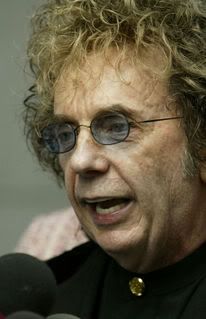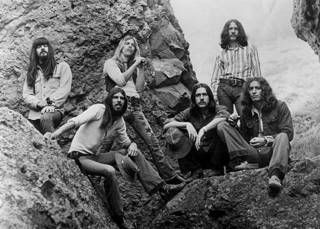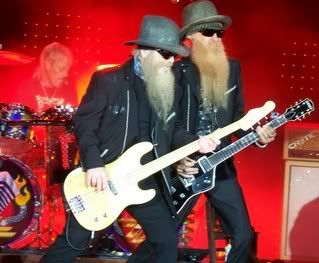
ZZ Top
By STEVE SEYMOUR
In the end, it was all about the blues.
The classic American musical style brought people together for fun when ZZ Top played in Harris, and for charity when friends and fans of Jim "Smiley" Lewis gathered to honor the late musician during a get together at the Terrace.
The Texas trio packed fans of all ages into the showroom at Chip-In's Island Resort and Casino for two shows, while the "Paws for the Blues" tribute raised funds for the Delta County Animal Society, Smiley's favorite charity.
My wife Sue and I attended both events, coming away with the belief that music is a mighty force, doubly powerful when you talk about the blues that inspired both Lewis and the self-described Little Ol' Band From Texas. Were it possible, you know that Lewis, who died in 2005, would trade blues licks on stage with ZZ Top's Billy Gibbons, not missing a beat. You could imagine they'd talk about some tasty Muddy Waters' song which influenced them in their early careers when other folks paid little attention to the blues.
The blues genre has escaped obscurity and is now widely recognized as the foundation for rock 'n' roll. ZZ Top made that fact evident as they brought their Hollywood Blues Tour 2007 to the Upper Peninsula.
Gibbons, the band's lead guitarist, explained their history to the crowd: "We come up a long way, y'all. We been doing this a long, long time. It's the same three guys here, playing the same three chords for y'all. Been doing this for you for 35 years."
The band enjoyed early success in the 70s with songs like "La Grange" and "Tush" and again in the mid-80s when they were discovered by the newly popular MTV which helped propel "Legs" into the Top Ten.
A diverse casino crowd heard those songs and more than a dozen others as Gibbons, bassist Dusty Hill and drummer Frank Beard demonstrated their choreographed guitar chops and syncopated drum beats.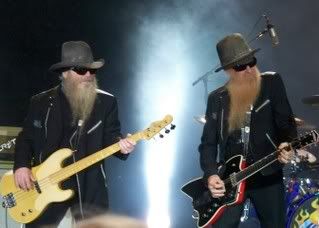
Yes, the bearded Gibbons and Hill wore their patented silver trimmed black suits, hats and "cheap sunglasses." And, yes, they produced lots of sturdy sound.
But, if there were to be a fourth member of the band, it would certainly be the person in charge of the electroluminescence, also known as the lighting guy. The band performed in front of a LED drape which displayed rapidly changing images, including one of the '32 Ford Roadster from the band's videos and popular "Eliminator" album.
In fact, the show opened with "Got Me Under Pressure," just one of four songs the band played from that enormously popular 1983 LP.
Since the band was touring without a new album, the 19-track set delved exclusively into ZZ Top's back catalog. They got down and dirty with "I'm Bad, I'm Nationwide," "Pearl Necklace," "Just Got Paid," "Gimme All Your Lovin'," "Sharp-Dressed Man" and "Tube Snake Boogie."
Gibbons announced, "It's blues time," before the band tackled "Blue Jean Blues," then slipped into a fiery version of the Jimi Hendrix gem "Foxey Lady," the only non-original song on the set list.
Although they encouraged the band with plenty of whopping and hollering, the audience also appeared to respect the honesty in which the band played, capturing the blues from within while delivering it with hard rock style.
Quite simply, the Friday, Oct.19 ZZ Top concert was the best show I've seen at the casino, bar none. But, my blues weekend wasn't over yet.
Next up was the second annual tribute to Jim Lewis, held Saturday, Oct. 20 at Escanaba's Terrace Bay Inn. Organized by Wendy Pepin, the event showcased Smiley's musician friends performing gratis, with proceeds going to the local animal shelter.
Smiley was remembered for his lifelong dedication to live music. He started in a folk duo while still in high school, and was a member of pioneering local rock band, Beat Inc. Through the years, he joined or founded other rock, country and blues bands, including such memorable groups as Black Dog, Blues Bombers and the Shuffle-aires.
Although the stage at the Terrace wasn't elaborate, the playing was just as genuine, spontaneous and ultimately rewarding as a big-time casino show.
Hundreds turned out to honor Smiley, including fans, friends and dozens of musicians who took the stage to play not only blues, but rock, country, bluegrass, rockabilly and more.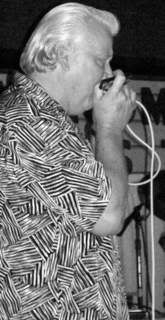
"Big Al" Ek
Judging from the turnout of performers and fans it was evident that Lewis had an large and lasting impact as a musician and friend during a career which spanned more than four decades, including stints in lower Michigan, Milwaukee and Las Vegas.
Performances went on without a hitch during the marathon ten-hour show headlined by "Big Al" Ek, well-known Las Vegas musician who played with Lewis in the Shuffle-aires. 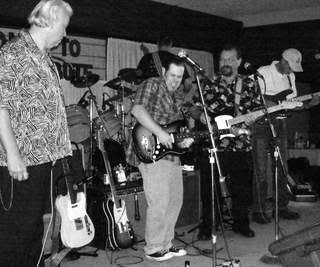
Jim Lewis Tribute Band
During three jam sessions, Ek was joined on stage by musical brethren the Lark Brothers, Steve "Doc" Yankee, Bruce Douglas, Mike Riegel, Dave Cass, Dick Miller, Rich White, Joe Heribacka and Fred Cavill.
Bill Lark opened the tribute by leading the band through a commanding version of "Wait On Time," originally recorded by the legendary Fabulous Thunderbirds, another Texas outfit. Dave Lark added "Crosscut Saw," while Ek put his personal stamp on "Big Boss Man," blowing some expressive harp.
Following the opening jam session, Chicago's Mike Felten offered a set of original acoustic material. A former Iron Mountain resident, he was once in a band with Lewis called "Blue River." Next came Sit Down Francis which featured another of Smiley's friends, Troy Sovey on guitar.
Larry Brown brought his Bounty Hunter group to the stage saying, "Jim was one of my best friends. I'm proud to say I own several of his guitars." Brown's daughter Cera offered inspired lead vocals on "Black Velvet" and "The Rose."
Local group Pink Zinc, with guest keyboardist John Beck, played energetic versions of a wide variety of seldom heard cover songs by Duran Duran, Depeche Mode, Midnight Oil and other period groups.
The versatile Ek returned to the stage to play mandolin and harp with local bluegrass enthusiasts Grassfire. Their fare ranged from the Stanley Brothers to Steve Earle.
Five piece Hey Mikey filled the dance floor with their brand of no-nonsense rock from Lynyrd Skynyrd, Free, Steve Ray Vaughan and Neil Young. They even paid their respects to the venerable ZZ Top with "Tush," straight out of 1975.
Twelve-bar songs returned to the stage with the arrival of Fast Eddie's Blues Band from Marquette. They opened with a raucous version of Charlie Musslewhite's "Blues Overtook Me." The band gave the blues a workout on such chestnuts and "Rocket 88," "Mona" and "Walking the Dog."
The all-star jam band closed the evening by improvising another set of blues standards. As a great summation of the day, Dave Lark led the band through a hardy take on "Everyday I Have the Blues," while brother Bill took vocals on an explosive version of "I'm Tore Down."
First recorded by Texas blues master Freddie King in 1961, "I'm Tore Down," also found its way onto Smiley's set list many years ago. A perfectionist at heart, Lewis performed it with an informed growl, also paying close attention to King's instrumental precision. Both traits were hallmarks of Smiley's style.
During the band's early days, ZZ Top was fortunate enough to perform with King, incorporating some of the bluesman's techniques into their own songs.
So it is that Smiley's career and ZZ Top intersect in the music of Freddy King.
That pleasant little coincidence made my blues weekend complete.
